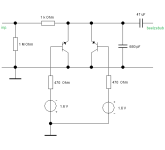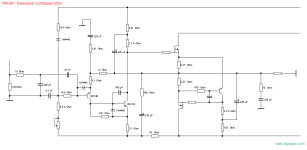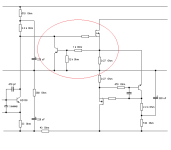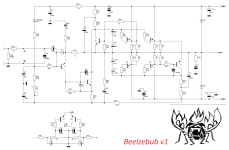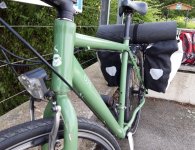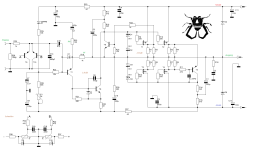Please don't think that the user hbtaudio is fixated on his first, quick idea. He is open to all possible improvements and options - you, dear reader, are free to decide for yourself what to put together with the well known Lego bricks. The only important thing is that you enjoy it (and that it works).
Based on the initial idea, I add another picture.
If you set a positive output DC offset with the trimming potentiometer, say <60mV, your first Beelzebub or babe is most likely stable and crisis-proof. A negative offset will drive the drift further in the negative direction.
#
There are many ways of limiting the maximum possible (signal) current flow through the N-MOS to the same level as the P-MOS. This is not a problem at all
Based on the initial idea, I add another picture.
If you set a positive output DC offset with the trimming potentiometer, say <60mV, your first Beelzebub or babe is most likely stable and crisis-proof. A negative offset will drive the drift further in the negative direction.
#
There are many ways of limiting the maximum possible (signal) current flow through the N-MOS to the same level as the P-MOS. This is not a problem at all
Attachments
In addition to a switch-on delay, the output relay and the DC protection, there is now really nothing vital missing to make the project a reality!
#
I am attaching the simplest of all solutions to the wahab's puzzle. But the input-side soft clipper, Beelzebub's shield, should actually be a standard feature for every amplifier, LTP or not.
 .
.
#
I am attaching the simplest of all solutions to the wahab's puzzle. But the input-side soft clipper, Beelzebub's shield, should actually be a standard feature for every amplifier, LTP or not.
 .
.Attachments
"Notgedrungen"What are the MOSFETs you recommend?
I will have to choose between the pair IRFP240 & 9240 or IRF540 & 9540. I'm leaning towards the physically smaller ones. In the parallel circuit, as shown in your nice posting #113.
One more note:
#
Ultimately, a blind test of all the options would be an incredibly interesting undertaking. I therefore advocate sounding out the options shown in this thread.
Have fun with the possible test setups and the decision for the Bub or the Babe,
HBt.

- the combination of the BD140-16 & BD139-16, which I consider together as the first stage (so this option is a very simple amplifier), cannot possibly come up with THDs that call for bragging
- the Beelzebub principle is deliberately designed by me as a quick and dirty design, "LineUp" has shown us how the simple combination of IPVA stage plus pp source follower can be raised to a rather clean and harmless level.
#
Ultimately, a blind test of all the options would be an incredibly interesting undertaking. I therefore advocate sounding out the options shown in this thread.
Have fun with the possible test setups and the decision for the Bub or the Babe,
HBt.

In search of further alternatives
A look at the famous schematics of the NAD3020 offers us a magical option for the IP-VA stage of "the Bub".
Anyone who dares to feed the simulator with this option ...

😉
A look at the famous schematics of the NAD3020 offers us a magical option for the IP-VA stage of "the Bub".
Anyone who dares to feed the simulator with this option ...
😉
IRF540 and IRF9540 are very good mosfets and they are TO-220 devices."Notgedrungen"
I will have to choose between the pair IRFP240 & 9240 or IRF540 & 9540. I'm leaning towards the physically smaller ones. In the parallel circuit, as shown in your nice posting #113.
This is the best I can do so far. Post #113.@hbtaudio
Here is the best I can do with Beelzebub parallel version.
Distortion is only THD 0.00034%
View attachment 1345568
It has got low distortion enough. There is no reason to invent it further.
It is a good amplifier.
Thank you very much for your encouragement, I probably look at the case in exactly the same way as you do.
Actually i'm interested in the blind test between the different front ends, but now some amplifiers have to be given the light of day.
In general,
I think a lot of the real practical test.
Courageous comrades-in-arms are wanted again,
HBt.
Actually i'm interested in the blind test between the different front ends, but now some amplifiers have to be given the light of day.
In general,
I think a lot of the real practical test.
Courageous comrades-in-arms are wanted again,
HBt.
First version,
not yet tested in reality - my test setup is still dormant, I'm too warm. Climate change has been killing me since May.
So if one feel unsure,
you should wait until someone has realized a test setup. However, I do not anticipate any problems.
#
I'm quite behind my personal schedule, the 25W krill was supposed to see the light of day first ... now I've changed my plans and wanted to build the Beelzebub_v1 in the first two weeks of September, but at almost 30°C in my rooms ... hopefully it will be colder next week.
greetings,
HBt.
not yet tested in reality - my test setup is still dormant, I'm too warm. Climate change has been killing me since May.
So if one feel unsure,
you should wait until someone has realized a test setup. However, I do not anticipate any problems.
#
I'm quite behind my personal schedule, the 25W krill was supposed to see the light of day first ... now I've changed my plans and wanted to build the Beelzebub_v1 in the first two weeks of September, but at almost 30°C in my rooms ... hopefully it will be colder next week.
greetings,
HBt.
- Home
- Amplifiers
- Solid State
- Beelzebub: 25 Watt for 8 Ohms
